(Press-News.org) WINSTON-SALEM, N.C. – Nov. 20, 2012 – If you are among the 50 percent of Americans who suffer from insomnia, then you have probably tried everything – from warm milk to melatonin pills or prescription medications to induce sleep – with varying degrees of success and side effects. But what if sleep could be achieved not by a substance, but through 'balancing' brain activity?
Researchers at Wake Forest Baptist Medical Center have conducted a pilot clinical study to determine whether a non-invasive approach, that uses musical tones to balance brain activity, can 'reset' the brain and effectively reduce insomnia.
The study, was published online in October, advance of print, in the journal Brain and Behavior. It was funded by a $26,696 grant from Brain State Technologies, LLC, Scottsdale, Ariz., the company that owns the technology used in the study.
Charles H. Tegeler, M.D., professor of neurology at Wake Forest Baptist and principal investigator of the study explained how the technology works. "The human brain is made up of the left and right hemispheres that work together as parallel processors. When a person undergoes trauma or a major stressor, their autonomic survival responses kick in and the brain can become unbalanced. If those imbalances persist, symptoms such as insomnia can result. Our study looked at a new technology that is intended to facilitate greater balance and harmony in brain frequencies, which may result in improved symptoms."
The new technology is called HIRREM, high-resolution, relational, resonance-based, electroencephalic mirroring or, as it's commercially known, Brainwave Optimization™. The non-invasive procedure uses a system that is designed to reflect the brain's frequencies back to itself using musical tones. Resonance between the musical tones and the electrical energy in a person's brain can bring balance to the two hemispheres of the brain.
Study results were based on a change in the Insomnia Severity Index (ISI) which measures the severity of sleep disruption using a zero-to-28 point scale; the median ISI for study participants was between 18.7 and 18.9, which is considered moderate-to-severe insomnia.
Researchers found that the HIRREM group had a 10.3 point drop in ISI, improved insomnia symptoms and, clinically moved into a category of 'no insomnia' or 'sub-threshold insomnia'. The control subjects, who continued their existing insomnia treatment without HIRREM, showed no change in ISI. However, when the crossover control group received HIRREM therapy, the results were indistinguishable from those of the original HIRREM group.
This unblinded, wait-list control, crossover study enrolled 20 participants (14 women and 6 men). Ten people were randomized to receive HIRREM sessions, plus usual care; the remaining 10 were assigned to the wait-list control group. An initial assessment determined the symmetry, or balance, in amplitude and frequencies between the brain hemispheres and data collection included a subject's ISI and other measures including blood pressure and neurocognitive function tests.
Study participants randomized to HIRREM underwent eight to 12 sessions that each lasted between 60-90 minutes. The sessions involved reclining in a zero gravity chair and placing sensors over numerous locations on both sides of the scalp. A musical tone, determined by a mathematic algorithm and based on the dominant frequency in a floating middle range of the participant's EEG frequencies, was played back to the participant through ear buds. Resonance between musical tones and oscillating brain circuits is designed to allow the brain to auto-calibrate, moving towards better balance, with associated improvement in symptoms.
The limitations of the study include the small number of study participants and the absence of a sham-placebo control group which prevented blinding. This means it is possible that the changes observed with HIRREM, could be due to a placebo effect. In addition, because HIRREM therapy involves social interaction and relaxation, there may be other non-specific mechanisms for improvement, in addition to the tonal mirroring. Although the researchers believe that the degree of improvement and length of time it persisted (for four weeks after the last session) suggests real change through HIRREM, Tegeler is planning a larger clinical trial using a sham placebo, to confirm the HIRREM effect and further explore the technology.
###
Co-authors in the study are Sandhya R. Kumar, M.D., Dave Conklin, MS III, Dana P. Turner, MSPH, Catherine L. Tegeler, B.S., and Tim T. Houle, M.D., of Wake Forest Baptist Medical Center, Brian C. Fidali, MS I, now of Weill Cornell Medical College of Cornell University, as well as Lee Gerdes and Sung W. Lee, M.D., of Brain State Technologies, LLC.
Disclosure: The Wake Forest faculty has no conflicts of interest, no direct financial relationships or positions with Brain State Technologies, LLC, which owns the HIRREM technology. Sung Lee, M.D., is research coordinator for Brain State Technologies, LLC and Lee. E. Gerdes is the inventor of the HIRREM technology and CEO of Brain State Technologies, LLC.
Music to the ears for a good night's sleep?
Wake Forest Baptist studies new therapy for insomnia
2012-11-20
ELSE PRESS RELEASES FROM THIS DATE:
Maple syrup, moose, and the local impacts of climate change
2012-11-20
Millbrook, N.Y. -- In the northern hardwood forest, climate change is poised to reduce the viability of the maple syrup industry, spread wildlife diseases and tree pests, and change timber resources. And, according to a new BioScience paper just released by twenty-one scientists, without long-term studies at the local scale—we will be ill-prepared to predict and manage these effects.
Following an exhaustive review of more than fifty years of long term data on environmental conditions at the Hubbard Brook Experimental Forest, located in the White Mountains of New Hampshire, ...
Timely change for tweeters' tune
2012-11-20
Do birds change their tune in response to urban noise? It depends on the bird species, according to Dr. Alejandro Ariel Ríos-Chelén from the Universidad Nacional Autónoma de México and colleagues. Their work shows that while some birds do adapt their songs in noisy conditions by means of frequency changes, others like the vermilion flycatchers adapt their song by means of changes in song lengths. The work is published online in Springer's journal, Behavioral Ecology and Sociobiology.
Birds use their songs during social interactions to attract females and repel intruders. ...
Huddersfield professor's ground-breaking research shows just how well the 2012 Games were run
2012-11-20
UNIQUE research conducted by a University of Huddersfield professor confirms just how successfully the 2012 Olympics and Paralympics were designed, organised and delivered. His findings will reveal to planners of the 2016 Games in Brazil just what they must do to meet or exceed the standards set by London.
Professor David Bamford, an expert in the theory of operations management and how it can be applied to the sports arena, was granted full access to the Paralympics village in London and with his team of researchers he quizzed hundreds of athletes, seeking their views ...
Robotic fish research swims into new ethorobotics waters
2012-11-20
NEW YORK, November 20, 2012 – Researchers at the Polytechnic Institute of New York University (NYU-Poly) have published findings that further illuminate the emerging field of ethorobotics — the study of bioinspired robots interacting with live animal counterparts.
Maurizio Porfiri, associate professor of mechanical and aerospace engineering at NYU-Poly, doctoral candidates Vladislav Kopman and Jeffrey Laut and research scholar Giovanni Polverino studied the role of real-time feedback in attracting or repelling live zebrafish in the presence of a robotic fish.
Their ...
Proposals to record the age of youngsters when buying mobile phones
2012-11-20
Mobile telephone operators should verify the age of children and youngsters when they access multimedia services by having a record of users' dates of birth. This is one of the recommendations in a report by researchers from the Polytechnic University of Valencia (Spain), that also suggest content classifications for mobiles by age, like in the case of video games.
"Verification of age upon access to mobile phone services is not effective because the child can also falsify their age by checking a different box," as explained to SINC by María de Miguel Molina, lecturer ...
Wolters Kluwer Health and International Association of Forensic Nurses partner to publish the Journal of Forensic Nursing
2012-11-20
New York, NY -- (November 20, 2012) – Wolters Kluwer Health and the International Association of Forensic Nurses (IAFN) are pleased to announce an agreement to publish Journal of Forensic Nursing, the official journal of IAFN. Lippincott Williams & Wilkins (LWW), part of Wolters Kluwer Health, will become the publisher for Journal of Forensic Nursing, beginning with the first Quarter 2013 issue.
The only journal dedicated exclusively to this emerging nursing specialty, the Journal of Forensic Nursing will continue on its quarterly publication schedule. In addition to ...
Researchers improve technology to detect hazardous chemicals
2012-11-20
Scientists at Imperial College London have developed a system to quickly detect trace amounts of chemicals like pollutants, explosives or illegal drugs.
The new system can pick out a single target molecule from 10 000 trillion water molecules within milliseconds, by trapping it on a self-assembling single layer of gold nanoparticles.
The team of scientists, all from the Department of Chemistry at Imperial, say this technology opens the way to develop devices that are compact, reusable and easy to assemble, and could have a range of uses including detecting illegal drugs, ...
Engineered bacteria can make the ultimate sacrifice
2012-11-20
HEIDELBERG, 20 November 2012 – Scientists have engineered bacteria that are capable of sacrificing themselves for the good of the bacterial population. These altruistically inclined bacteria, which are described online in the journal Molecular Systems Biology, can be used to demonstrate the conditions where programmed cell death becomes a distinct advantage for the survival of the bacterial population.
"We have used a synthetic biology approach to explicitly measure and test the adaptive advantage of programmed bacterial cell death in Escherichia coli," said Lingchong ...
Impulsivity in first grade predicts problem gambling in late teen years for urban boys
2012-11-20
November 20, 2012 -- Results of a new study by researchers at Columbia University's Mailman School of Public Health indicate that a developmental pattern of impulsiveness in young males is linked with gambling problems in late adolescence. Respondents considered to be in the high impulsivity track as early as first grade doubled the odds of meeting criteria for at-risk/problem gambling, and tripled the odds of meeting criteria for problem gambling. The study is the first to link a developmental pattern of impulsivity -- defined as a tendency to make rush decisions without ...
More than a machine
2012-11-20
Viruses can be elusive quarry. RNA viruses are particularly adept at defeating antiviral drugs because they are so inaccurate in making copies of themselves. With at least one error in every genome they copy, viral genomes are moving targets for antiviral drugs, creating resistant mutants as they multiply. In the best-known example of success against retroviruses, it takes multiple-drug cocktails to corner HIV and narrow its escape route.
Rather than target RNA viruses themselves, aiming at the host cells they invade could hold promise, but any such strategy would have ...
LAST 30 PRESS RELEASES:
Statins significantly reduce mortality risk for adults with diabetes, regardless of cardiovascular risk
Brain immune cells may drive more damage in females than males with Alzheimer’s
Evidence-based recommendations empower clinicians to manage epilepsy in pregnancy
Fungus turns bark beetles’ defenses against them
There are new antivirals being tested for herpesviruses. Scientists now know how they work
CDI scientist, colleagues author review of global burden of fungus Candida auris
How does stroke influence speech comprehension?
B cells transiently unlock their plasticity, risking lymphoma development
Advanced AI dodel predicts spoken language outcomes in deaf children after cochlear implants
Multimodal imaging-based cerebral blood flow prediction model development in simulated microgravity
Accelerated streaming subgraph matching framework is faster, more robust, and scalable
Gestational diabetes rose every year in the US since 2016
OHSU researchers find breast cancer drug boosts leukemia treatment
Fear and medical misinformation regarding risk of progression or recurrence among patients with breast cancer
Glucagonlike peptide-1 receptor agonists and asthma risk in adolescents with obesity
Reviving dormant immunity: Millimeter waves reprogram the immunosuppressive microenvironment to potentiate immunotherapy without obvious side effects
Safety decision-making for autonomous vehicles integrating passenger physiological states by fNIRS
Fires could emit more air pollution than previously estimated
A new way to map how cells choose their fate
Numbers in our sights affect how we perceive space
SIMJ announces global collaborative book project in commemoration of its 75th anniversary
Air pollution exposure and birth weight
Obstructive sleep apnea risk and mental health conditions among older adults
How talking slows eye movements behind the wheel
The Ceramic Society of Japan’s Oxoate Ceramics Research Association launches new international book project
Heart-brain connection: international study reveals the role of the vagus nerve in keeping the heart young
Researchers identify Rb1 as a predictive biomarker for a new therapeutic strategy in some breast cancers
Survey reveals ethical gaps slowing AI adoption in pediatric surgery
Stimulant ADHD medications work differently than thought
AI overestimates how smart people are, according to HSE economists
[Press-News.org] Music to the ears for a good night's sleep?Wake Forest Baptist studies new therapy for insomnia





